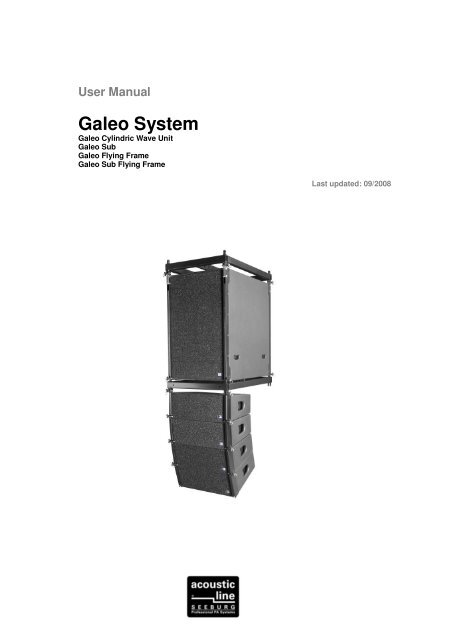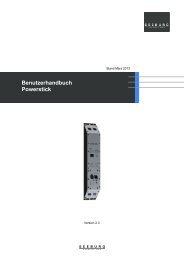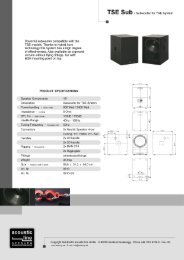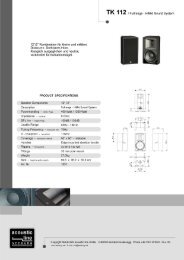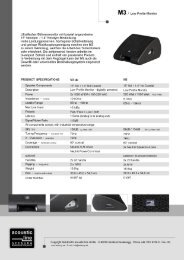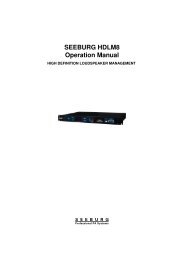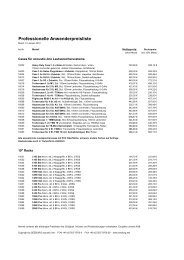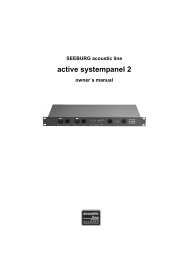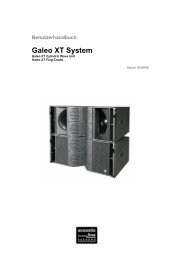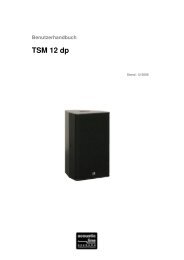You also want an ePaper? Increase the reach of your titles
YUMPU automatically turns print PDFs into web optimized ePapers that Google loves.
User Manual<br />
<strong>Galeo</strong> <strong>System</strong><br />
<strong>Galeo</strong> Cylindric Wave Unit<br />
<strong>Galeo</strong> Sub<br />
<strong>Galeo</strong> Flying Frame<br />
<strong>Galeo</strong> Sub Flying Frame<br />
Last updated: 09/2008
Contents<br />
Foreword................................................................................3<br />
Part 1 – General Information<br />
Components...........................................................................4<br />
Safety instructions ..................................................................5<br />
Coverage................................................................................6<br />
Possible combinations, groundstack <strong>Galeo</strong>.............................7<br />
Combination with <strong>Galeo</strong> XT ....................................................9<br />
Part 2 – Assembly and Rigging<br />
Transportation ...................................................................... 10<br />
EASE Focus......................................................................... 11<br />
Assembly and disassembly, flown operation ......................... 12<br />
Assembly and disassembly, groundstack operation .............. 15<br />
Part 3 – <strong>System</strong> Start-up<br />
<strong>System</strong> rack.......................................................................... 16<br />
Controller setups .................................................................. 17<br />
Cabling................................................................................. 18<br />
Sound optimisation............................................................... 19<br />
2<br />
SEEBURG <strong>acoustic</strong> <strong>line</strong>
Foreword<br />
The GALEO Line Array <strong>System</strong> is suitable for a wide range of sound<br />
applications for which a fast set-up, high sound quality, long throw and<br />
predictable directivity are crucial. It is particularly suitable for high-end<br />
permanent installations.<br />
The <strong>Galeo</strong> Sub with integrated flying hardware for flown array applications and<br />
groundstack operation serves as a bass extension. Thanks to hornloaded<br />
bandpass technology in conjunction with the 18“ ND long excursion chassis<br />
with exceptionally powerful drive conceived exclusively for this unit, the <strong>Galeo</strong><br />
Sub offers a high level of bass, lowest distortion and a long throw.<br />
Please read this user manual carefully and follow the instructions provided. It<br />
should be within reach at all time when setting up the <strong>Galeo</strong> system in order to<br />
be able to find a solution to any queries.<br />
With the purchase of a <strong>Galeo</strong> system you will have also received a structural<br />
analysis certificate that will provide information on the materials used and their<br />
maximum resilience.<br />
Should you require additional information or have any helpful suggestions<br />
regarding this user manual, please contact<br />
SEEBURG <strong>acoustic</strong> <strong>line</strong> Produktions- und Vertriebsgesellschaft mbH<br />
Auweg 32<br />
89250 Senden-Freudenegg<br />
Germany<br />
07307 / 9700 – 0<br />
www.seeburg.net<br />
info@seeburg.net<br />
3<br />
SEEBURG <strong>acoustic</strong> <strong>line</strong>
Part 1 – General Information<br />
Components<br />
The <strong>Galeo</strong> system comprises the <strong>Galeo</strong> Cylindric Wave Units and a compatible<br />
<strong>Galeo</strong> Sub bass extension of the same width and includes appropriate flying<br />
hardware.<br />
Die <strong>Galeo</strong> Cylindric Wave unit is to be understood as an individual element<br />
within a <strong>line</strong> array sound system. In combination with several different units, a<br />
cylindrical sound wave is emitted, especially within the mid and high ranges,<br />
which has a longer throw than comparable omni-directional systems. The 3-<br />
point flying hardware with ball lock pins allows simple and fast assembly,<br />
facilitating curving angles between 0° and 7° in 1° stages.<br />
The exclusive use of high-grade European-made components guarantees a<br />
high maximum sound pressure level with even horizontal directivity and<br />
excellent sound quality.<br />
A <strong>Galeo</strong> unit is fitted with two 8“ low-mid drivers and one 1.4“ HF driver. The<br />
<strong>acoustic</strong> crossover frequency is approximately 900 Hz.<br />
The two-way active operation is effected via system amping.<br />
The chassis, which is made of an aluminium and multilayered birch multiplex<br />
composite is polyurea-coated, providing it with adequate protection against<br />
rain. Likewise, all diaphragms have a special coating.<br />
The flying fittings are made of powder-coated steel, which also renders them<br />
weather resistant. However, after many years of use the coating of the fittings<br />
can become damaged and a light rust film may form on the steel parts if<br />
exposed to dampness for longer periods. Therefore, keep your <strong>Galeo</strong> system<br />
dry at all times and treat all critical areas regularly with suitable care products.<br />
The <strong>Galeo</strong> Sub features two 18“ cone drivers and covers a frequency range<br />
from 35 Hz to 80 Hz.<br />
4<br />
SEEBURG <strong>acoustic</strong> <strong>line</strong>
Safety instructions<br />
PA systems the size of the <strong>Galeo</strong> pose different types of risk:<br />
- aurally<br />
Even at a low power input the <strong>Galeo</strong> unit can produce a hazardous sound<br />
pressure level that may cause acute and permanent damage to the ear.<br />
Never sit or stand in the immediate vicinity of the loudspeaker during<br />
operation and always wear ear protection.<br />
Observe the respective German trade association regulation BGV B3<br />
pertaining to noise<br />
- mechanical<br />
During assembly and disassembly, moveable devices and falling parts may<br />
cause serious physical injury.<br />
Observe the respective German trade association regulation BGV D8<br />
pertaining to winches and hoisting gear (basic principles of prevention) as well<br />
as those regarding event and production facilities for the performing arts.<br />
- magnetic and electrical<br />
Even if not connected to a power source, loudspeakers produce a static<br />
magnetic field that can damage cards with a magnetic strip or delete sound<br />
recordings and the like. Amplifiers can emit dangerous voltage. This voltage is<br />
also present on free loudspeaker connectors. It is vital that these connectors<br />
are covered when not used or in wet conditions.<br />
Observe the safety instructions of the amplifier manufacturer and the<br />
respective German trade association regulation BGV A2 pertaining to electrical<br />
equipment and utilities.<br />
Assembly and disassembly of a <strong>Galeo</strong> PA system must be carried out only by<br />
qualified personnel who are familiar with the corresponding regulations and<br />
adhere to and act in accordance with them. Please note that all quoted<br />
regulations are predominantly applicable in Germany. Work in compliance with<br />
the regulations applicable in the country you are in.<br />
5<br />
SEEBURG <strong>acoustic</strong> <strong>line</strong>
Coverage<br />
In the case of large format PA systems, coverage is of the utmost importance.<br />
Very few listeners stand or sit directly within the axis of a <strong>line</strong> array system.<br />
Consequently, when developing the <strong>Galeo</strong> our engineers attached great<br />
importance to achieving totally symmetrical coverage that is evenly and<br />
horizontally distributed across the entire frequency range.<br />
The midrange drivers feature cover panels according to the AMR (Air Mass<br />
Reflection) principle, which serve at the same time as sound guidance for the<br />
HF drivers.<br />
Due to the specific arrangement, depth and quantity of boreholes, an ideal ratio<br />
between sound passage for the low-mid range and horn guidance for the high<br />
range is obtained.<br />
The <strong>Galeo</strong> comes as standard with cover panels with which even coverage of<br />
around 120° is achieved within the mid-high range (Art. Nr. 00400). By<br />
exchanging the 120° panels for panels with an 80° horn function, the nominal<br />
coverage angle can be modified accordingly (Art. Nr. 0400/80). This<br />
modification is particularly useful in the case of the upper units of a <strong>line</strong> array<br />
system, when a broad coverage angle is not required but throw is to be<br />
increased. The front guard is held in place by 4 small neodymium magnets and<br />
secured via a steel cable (safety).<br />
Vertical coverage is adjusted by curving and the angle of inclination (see EASE<br />
FOCUS).<br />
Normally, the <strong>Galeo</strong> Sub has almost omni-directional sound distribution with a<br />
attenuation of –6 dB on the back side.<br />
When using several <strong>Galeo</strong> Sub dps, the active version of the <strong>Galeo</strong> Sub<br />
featuring integrated power amps, it is possible to achieve kidney-shaped<br />
coverage. Behind the loudspeakers there is a broadband cancellation of<br />
approximately 20dB. This mode of operation is to be selected when the sound<br />
level produced by the subwoofer behind the loudspeaker box is considered<br />
unpleasant. For further information refer to the <strong>Galeo</strong> Sub dp user manual.<br />
Likewise, the coverage angle of subwoofers can also be influenced by specific<br />
positioning and corresponding delays.<br />
6<br />
SEEBURG <strong>acoustic</strong> <strong>line</strong>
Possible combinations, groundstack <strong>Galeo</strong><br />
The lower cut-off frequency of the <strong>Galeo</strong> Cylindric Wave Unit is approximately<br />
80Hz. Therefore, trouble-free speech or general corporate applications are<br />
possible without using an additional subwoofer.<br />
However, in the case of disco or live events, the <strong>Galeo</strong> Sub will be required as<br />
an additional sub-bass extension. Fundamentally, there are three possibilities<br />
of combining the <strong>Galeo</strong> with the <strong>Galeo</strong> Sub.<br />
1. <strong>Galeo</strong> Sub and <strong>Galeo</strong> flown applications<br />
Use the <strong>Galeo</strong> Sub flying frame Art. No. 01389 and hang the required number<br />
of woofers below it. A further <strong>Galeo</strong> Sub flying frame, to which <strong>Galeo</strong> units are<br />
attached, is mounted below the lowermost <strong>Galeo</strong> Sub. It is essential that you<br />
observe the permitted total load stipulated in the structural analysis certificate<br />
and the warning notices provided by EASE Focus.<br />
The best <strong>acoustic</strong> results are obtained if both <strong>Galeo</strong> Sub and <strong>Galeo</strong> are flown<br />
within the immediate vicinity of each other (one below the other). Within the<br />
crossover frequency all sound emitting sources are close together in relation to<br />
the wavelength, resulting in an optimum addition. However, flown operation of<br />
basses does not facilitate ground-coupling. Therefore, the maximum level is<br />
lower in comparison to groundstack operation.<br />
Never hang a <strong>Galeo</strong> Sub on the stacking device below a <strong>Galeo</strong> <strong>line</strong> array.<br />
2. <strong>Galeo</strong> Sub stacked, <strong>Galeo</strong> flown<br />
In practice, this arrangement is the most frequently used. Through curving and<br />
the angle of inclination of the flown <strong>Galeo</strong>, it is possible to achieve an ideal<br />
alignment of the mid-high range, whilst the directivity of the <strong>Galeo</strong> Sub can be<br />
influenced by differing <strong>line</strong>-up and delays. In addition, due to the comparably<br />
low crossover frequency of 80Hz, the subwoofers are normally not locatable.<br />
Thanks to the steep crossover of 24dB/oct, interference between the <strong>Galeo</strong><br />
and the <strong>Galeo</strong> Sub is kept to a minimum.<br />
7<br />
SEEBURG <strong>acoustic</strong> <strong>line</strong>
3. <strong>Galeo</strong> Sub und <strong>Galeo</strong> stacked<br />
For groundstack operation of <strong>Galeo</strong> on top of <strong>Galeo</strong> Sub no frame is required.<br />
The <strong>Galeo</strong> units are mounted directly onto the stacking device of the <strong>Galeo</strong><br />
Sub and the front spacer. This device offers a wide angular adjustment range<br />
so that the lowermost unit can also be inc<strong>line</strong>d downwards on high<br />
groundstacks.<br />
Observe the maximum stacking height for open-air events (danger in strong<br />
winds) and secure the entire stack in such a way as to exclude the possibility of<br />
toppling or movement.<br />
For inclination angles ranging from 3.5° to – 3.5° the stacking device rests on<br />
the upper steel plate and is secured using the ball lock pin.<br />
In the case of larger inclination angles ranging from -6° bis -12° the spacer of<br />
the <strong>Galeo</strong> is inserted into the stacking device and secured using the ball lock<br />
pin.<br />
Alternatively, the <strong>Galeo</strong> flying frame can be extended into a stacking frame, so<br />
that it is also possible to stack the <strong>Galeo</strong> without the <strong>Galeo</strong> Sub. This set-up<br />
can then be mounted on TSE infra bass extensions placed horizontally on the<br />
floor.<br />
For smaller sound applications a speaker pole can be screwed into the M20<br />
thread of the <strong>Galeo</strong> Sub. The flying shackle Art. Nr. 01385 can be used for<br />
assembling up to two <strong>Galeo</strong> units.<br />
8<br />
SEEBURG <strong>acoustic</strong> <strong>line</strong>
The <strong>Galeo</strong> combined with the <strong>Galeo</strong> XT<br />
Using a transition cradle Art. No. 01392, <strong>Galeo</strong> units can also be flown below a<br />
<strong>Galeo</strong> XT <strong>line</strong> array. Due to the specific geometry of the transition cradle, the<br />
cylindrical sound source within the mid-high range is continued; it can therefore<br />
be employed for virtually gapless down-fill operation with strong curving.<br />
Featuring the same high frequency drivers and the same midrange driver<br />
arrangement, the <strong>Galeo</strong> can be regarded as the the <strong>Galeo</strong> XT’s “little brother”.<br />
Therefore, the <strong>Galeo</strong> can by all means be additionally employed when the<br />
given maximum level requirements within the mid-high range cannot be<br />
achieved using the <strong>Galeo</strong> XT on its own, or if strong curving is desired at the<br />
lower end of the <strong>line</strong> array. A maximum of 6 <strong>Galeo</strong> units may be attached to the<br />
transition cradle and the permitted maximum load for the <strong>Galeo</strong> XT flying frame<br />
must not be exceeded.<br />
The transition cradle is secured in the upper borehole in the <strong>Galeo</strong> XT spacer<br />
of the lowermost unit using a ball lock pin. <strong>Galeo</strong> units are then attached as<br />
described later (Part 2 – and Rigging).<br />
Remember that when setting up the <strong>Galeo</strong> and <strong>Galeo</strong> XT, the delay times for<br />
the mid and high ranges must have the same setting. A separate <strong>Galeo</strong><br />
controller setting is necessary to ensure the ideal addition over the complete<br />
length of the array.<br />
9<br />
SEEBURG <strong>acoustic</strong> <strong>line</strong>
Part 2 – Assembly and Rigging<br />
Transportation<br />
For transportation of the <strong>Galeo</strong>, four units are packed in a flightcase (Art. No.<br />
16002). For assembly, either just the cover or the complete hood is removed<br />
from the case. The angle of the units stacked below each other must always be<br />
0° in the flightcase, and the two ball lock pins for assembly on the flying frame<br />
should be located in the rear fitting of the topmost <strong>Galeo</strong> element. The short<br />
Speakon connector cables NL4 can remain on the elements. When replacing<br />
the hood on the case or lowering the <strong>Galeo</strong> <strong>line</strong> array into the case, ensure that<br />
the viewing windows are on the rear side of the <strong>Galeo</strong>. This will enable you to<br />
check completeness and serial numbers at a glance.<br />
For transportation purposes the wheelboard Art. No. 01270 can be attached to<br />
the front of the <strong>Galeo</strong> Sub. Place both hooks (catches) in the upper and lower<br />
mounting eyes and then tighten the butterflies. Using the handle located on top<br />
the <strong>Galeo</strong> Sub can now be tilted forward onto the wheels.<br />
For transportation in a truck or on inc<strong>line</strong>d surfaces it is essential to engage the<br />
wheel brakes of the <strong>Galeo</strong> flightcase. The <strong>Galeo</strong> Sub is placed upright on the<br />
floor space to prevent rolling.<br />
For transporting two <strong>Galeo</strong> flying frames a separate accessory flightcase Art.<br />
No. 16003 is available in which replacement ball lock pins can also be stored.<br />
The <strong>Galeo</strong> Sub flying frame can remain attached to the <strong>Galeo</strong> Sub during<br />
transportation.<br />
10<br />
SEEBURG <strong>acoustic</strong> <strong>line</strong>
EASE Focus<br />
Make use of the <strong>Galeo</strong> system’s <strong>acoustic</strong> and mechanical simulation software<br />
EASE focus. It is available for download in the respective download area of our<br />
website www.seeburg.net. This software facilitates simple simulation of how<br />
the inclination and angle of the <strong>Galeo</strong> should be adjusted for obtaining the ideal<br />
sound for the audience area. When using the programme, observe any warning<br />
instructions and check the provided data for plausibility.<br />
Normally, the best results are achieved if the <strong>line</strong> arrays are pointing just above<br />
the heads of the audience and not hanging too high. As a rule you should try to<br />
be content with small curving angles and use the auto-splay function.<br />
The lowermost unit should be hung just above the heads of the persons on<br />
stage. The entire <strong>line</strong> array can then be operated one below the other with the<br />
boxes set at a slight angle to make full use of the advantages of <strong>acoustic</strong><br />
coupling (cylindrical wave). In addition, the amount of rigging required is<br />
reduced due to the fact that the system is flown only from one single point. If<br />
greater overall inclination angles than those obtainable with pinpoint 10 are<br />
required (explicit entry of inclination angle and not the pinpoint), the array must<br />
be raised to slightly below the centre of gravity via one or more additional<br />
straps.<br />
Print out at least the mechanical data provided by the EASE Focus simulation<br />
software in order to be able to adjust the degree of inclination and the angle<br />
exactly according to the instructions. Slight deviations can bring about<br />
significantly modified <strong>acoustic</strong>s.<br />
General information on the use of the EASE Focus Aiming Software is<br />
available on the internet at www.easefocus.de.<br />
For more accurate simulation incorporating room characteristics, system data<br />
for EASE 4.0 is also available in the download area of our website<br />
www.seeburg.net.<br />
11<br />
SEEBURG <strong>acoustic</strong> <strong>line</strong>
Assembly and disassembly – Flown operation<br />
Assembly and disassembly of the <strong>Galeo</strong> system must be carried out by<br />
qualified personnel only. Every technician or staff member working with the<br />
system must have access to this user manual and the structural analysis<br />
certificate and be familiar with the most essential contents.<br />
Only use chain hoists permitted in accordance with BGV C1 or BGV D8+<br />
respectively if there are any persons sitting or standing under the loudspeaker<br />
system. Ensure that chains do not become entangled with ball lock pins or<br />
cables. Bypass the motor with a steel cable (dead hung) or ensure that a<br />
second, independent and sufficiently dimensioned securing device is available.<br />
Only use accessories that conform to BGV C1 requirements and carry out all<br />
other work in compliance with BGV A1 or BGV C1 regulations respectively.<br />
These trade regulations can be viewed on the internet at<br />
www.arbeitssicherheit.de<br />
Do not assemble an array of <strong>Galeo</strong> loudspeakers that is not covered by the<br />
structural analysis certificate or has not been separately certified by a qualified<br />
person.<br />
The structural analysis certificate contains the following cases for flown<br />
operation using the <strong>Galeo</strong> flying frame.<br />
• up to 8 <strong>Galeo</strong> on pinpoint 6…10 (freely suspended)<br />
• up to 12 <strong>Galeo</strong> on pinpoint 1 with up to 20° overall inclination angle<br />
/curving via an additional vertical bracing at the centre of gravity.<br />
• Up to 16 <strong>Galeo</strong> on pinpoint and use of the 0°, 2°,4°, and 6° insertion<br />
points.<br />
The structural analysis certificate contains the following cases for flown<br />
operation using the <strong>Galeo</strong> Sub flying frame:<br />
• up to 2 <strong>Galeo</strong> Sub on pinpoint 6<br />
• up to 6 <strong>Galeo</strong> Sub or 2 <strong>Galeo</strong> Sub and 8 <strong>Galeo</strong> on pinpoint 1 and 12<br />
respectively, with a double-strand suspension system set at a 60°<br />
bridle angle.<br />
Using the system at wind force 8 and above is not permitted. From wind force 6<br />
operation is to be discontinued and the complete array placed on the ground<br />
and firmly secured.<br />
12<br />
SEEBURG <strong>acoustic</strong> <strong>line</strong>
Attach a <strong>Galeo</strong> <strong>line</strong> array only to flying points which have sufficient carrying<br />
capacity and are adequately dimensioned to bear heavier loads. If there are<br />
even the slightest concerns regarding correct dimensioning, either do not<br />
attach the system or arrange for the provision of the respective structural<br />
analysis certificate.<br />
The flying hardware of the <strong>Galeo</strong> system must be in impeccable condition.<br />
Lifting and load-bearing accessories must not show any signs of damage that<br />
may affect their function. Do not climb up the <strong>Galeo</strong> <strong>line</strong> array in order to<br />
change the inclination angle and the like.<br />
Danger of crushing to hands and fingers during adjustment of curving!<br />
Assembly and disassembly can be carried out by just two persons. The fully<br />
equipped <strong>Galeo</strong> case is rolled under the flying point, after which the lid of the<br />
flightcase (not the entire hood) is removed. Now assemble the flying frame and<br />
attach the shackle in the pinpoint according to the EASE Focus simulation to<br />
the chain hoist using an approved and adequately dimensioned shackle (BGV<br />
C1). Use the chain hoist to remove the <strong>line</strong> array from the flightcase and then<br />
set the degree of angulation:<br />
Whilst one person relieves the strain, the other person removes the rear ball<br />
lock pin from the unit of which the curving angle is to be adjusted. The ball lock<br />
pin is then reinserted into the respective borehole.<br />
When flying the <strong>Galeo</strong> Sub, adhere to the following procedure: Hoist up a bass<br />
speaker first, place the second one below it and place the upper one on top of<br />
it. Connect the speaker boxes via all four spacers using ball lock pins.<br />
After setting the degree of angulation, the already suspended array is hoisted<br />
up and lifted to working height. Further units can now be attached. In the case<br />
of longer arrays this procedure can be disadvantageous, particularly when the<br />
lowermost units are strongly angulated. These units are then individually raised<br />
up to working height and attached to the existing array.<br />
This also applies of course if there is no possible ground-level access to the<br />
flying frame.<br />
13<br />
SEEBURG <strong>acoustic</strong> <strong>line</strong>
M10 DIN 580 eye bolt<br />
Always first connect the units using the front ball lock pins and do not adjust the<br />
degree of angulation before the units have been securely connected. Ensure<br />
that the ball clearly protrudes from the other side of the fitting and that the pin<br />
cannot be withdrawn.<br />
Never under any circumstances should you attempt to withdraw a ball lock pin<br />
that cannot be easily moved by hand. In this case force is still in effect at the<br />
connecting point and releasing the pin can result in an abrupt jolting of the<br />
entire speaker array. Do not use tools. Never loosen the front connection only<br />
on one side and avoid any tilting of the housing in order not to damage the<br />
flying hardware.<br />
Never attempt to withdraw a ball lock pin without first pressing the fastener in<br />
the centre.<br />
Twisting of the <strong>line</strong> array can be avoided by the use of additional, usually<br />
unencumbered bracings. These can also prevent swaying in windy conditions.<br />
For this purpose use boreholes in the rear flying fitting or screw eye bolts DIN<br />
580 into the respective M10 points on the rear side.<br />
Disassembly is carried out in reverse order. Always loosen the rear<br />
connections first, then the ball lock pins on the front side. Then place the array<br />
on the ground and set all elements to 0° before replacing into the case.<br />
14<br />
SEEBURG <strong>acoustic</strong> <strong>line</strong>
<strong>Galeo</strong> groundstack, short extenders at front,<br />
long extenders at rear<br />
Assembly and disassembly – groundstack operation<br />
Using the stacking frame (reversed flying frame with extenders), a stacked<br />
<strong>Galeo</strong> array of up to 6 elements is possible without further ballasting. Insert the<br />
extenders into the holes in the flying frame and secure these using ball lock<br />
pins according to the assembly instructions.<br />
The floor space must be skid-proof, clean, even and sufficiently sustainable.<br />
Due to possible wind force, the top edge of the array must not be higher than<br />
5m above ground level. Observe the structural analysis certificate.<br />
Larger arrays are possible of course, but these must then be braced and<br />
secured accordingly in order to prevent toppling in windy conditions (separate<br />
certificate is required!).<br />
Do not assemble groundstacks in areas that are accessible to the public or<br />
where they can possibly even be knocked over in a panic situation.<br />
Using the stacking device on the top of the <strong>Galeo</strong> Sub, the <strong>Galeo</strong> can be<br />
mounted directly onto the <strong>Galeo</strong> Sub without the need for further stacking<br />
frames or similar devices. Stack the woofers first and connect them via the<br />
fittings. Then stack the <strong>Galeo</strong> units on top of the woofers.<br />
The structural analysis certificate contains the following cases for stacked<br />
operation at open-air events and up to wind force 8:<br />
• up to 6 <strong>Galeo</strong> on 1 <strong>Galeo</strong> Sub<br />
• up to 6 <strong>Galeo</strong> on the groundstack frame with extenders<br />
15<br />
SEEBURG <strong>acoustic</strong> <strong>line</strong>
Part 3 – Startup<br />
6HE DD <strong>System</strong> rack<br />
<strong>System</strong> racks<br />
<strong>System</strong> racks for <strong>Galeo</strong> applications are available ex factory. They consist of:<br />
• 4-channel amplifier lab.gruppen FP 10000 Q for the mid-high range<br />
(4x2500W/2 ohms)<br />
• 2-channel amplifier lab.gruppen FP 7000Q for the low range drivers<br />
(2x3500W/2 ohms)<br />
• 2 in 6 system controller BSS OmniDRIVE compact plus FDS 366 T<br />
• Connection panel with XLR inputs/loop thru and 4xNL4 Speakon out<br />
for connecting <strong>Galeo</strong> und <strong>Galeo</strong> Sub<br />
• Power supply 32A CEE with loop thru for up to 2 system racks<br />
connected to a 32A CEE socket<br />
These configured system racks offer maximum possible reliability. Other<br />
configurations are optionally available if desired.<br />
The wheelboard is connected to the rack with two standard M8 screws and is<br />
centred above the rubber feet. Therefore, it is possible to easily remove the<br />
wheelboard in order to stack the system racks on top of one another if only<br />
limited space is available.<br />
Use the system racks in accordance with the instructions provided by the<br />
manufacturer of the installed components. This comprises in particular<br />
protection against dampness and rain, the operating temperature range and<br />
the securing of an adequately dimensioned power supply.<br />
16<br />
SEEBURG <strong>acoustic</strong> <strong>line</strong>
Frequency response <strong>Galeo</strong><br />
Controller settings<br />
In addition to inclination angle and curving, correct configuration of the system<br />
controller has a decisive effect on the <strong>Galeo</strong> Line Array’s sound characteristics.<br />
As sound perception and use of the system differ greatly, only basic settings<br />
are proposed, the equalising of which must be effected on location. Here<br />
mainly the crossover frequency with slew rate and filter type are predefined and<br />
the frequency response settings of the individual paths required for the<br />
functioning of the system. The limiter and delay values are optimally set at the<br />
factory and should not be changed.<br />
The system controllers are supplied with settings for 4, 6 and 8 elements. The<br />
longer the speaker array, the more the low and mid ranges are amplified by<br />
<strong>acoustic</strong> coupling, meaning that these must be lowered in the controller .<br />
However, experience shows that longer arrays are usually also used to achieve<br />
higher sound intensity. The corresponding increase in the low and mid ranges<br />
accommodates the listener’s natural perception of sound volume and should<br />
not be entirely compensated.<br />
Adapting to taste and room application should always be effected on the<br />
master equaliser or the input equalizer of the system controller in order not to<br />
affect the phasing of the single paths in relation to each other at the crossover<br />
frequency.<br />
17<br />
SEEBURG <strong>acoustic</strong> <strong>line</strong>
Cabling<br />
The <strong>Galeo</strong> units are connected to each other and to the system rack by means<br />
of 4-core NL4 Speakon cables. Use only high-quality 1:1 configured, flexible<br />
speaker cables with Neutrik plugs. The impedance of both paths is 16 ohms<br />
per loudspeaker box. Therefore, four units can be used simultaneously with a 4<br />
ohm amplifier using 30cm loop thru cable, and up to eight <strong>Galeo</strong> on a 2 ohm<br />
amplifier.<br />
The <strong>Galeo</strong> Sub also has NL4 connectors, impedance is 4 ohms. Two <strong>Galeo</strong><br />
Subs can be used simultaneously (loop thru) with 2 ohm amplifiers.<br />
For events necessitating permanent and extremely high demands on the power<br />
amplifier’s performance, 2 ohm operation is not recommended, even if the<br />
amplifier manufacturer has specified this mode of operation. Therefore, to<br />
achieve optimum operational safety, combine a maximum of six <strong>Galeo</strong> units<br />
per amplifier channel (2.7 ohm operation).<br />
The pin configuration of the speakon sockets is printed on the connection<br />
panels of the system rack and speaker cabinets.<br />
<strong>Galeo</strong><br />
1+/1- 1.4“ Hi<br />
2+/2- 8“ Low-mid<br />
<strong>Galeo</strong> Sub<br />
1+/1- not connected<br />
2+/2- Low<br />
In order to relieve strain on the Speakon connectors when using long speaker<br />
cables during flying operation, use a cord grip, which can be attached to the<br />
lower boreholes in the rear flying fitting or directly onto the flying frame.<br />
Avoid using long cables, but if long distances are unavoidable, use 4 x 4mm²<br />
cable instead of the normal 4 x 2.5mm² cable to keep voltage drop to a<br />
minimum.<br />
18<br />
SEEBURG <strong>acoustic</strong> <strong>line</strong>
Potential optimisation target curve<br />
Sound optimisation<br />
In order to be able to fully utilise the performance capability of the <strong>Galeo</strong><br />
system, you should adapt the sound system to the prevailing conditions and<br />
the respective setup at each location.<br />
The actual size of the sound application area should have already been<br />
predetermined during the EASE Focus simulation. The absolute throw is often<br />
less important than the production of superb sound between the stage and<br />
FOH position.<br />
When optimising, use music you are totally familiar with as well as tried and<br />
tested computerised measuring technology, incorporating a sufficiently <strong>line</strong>ar<br />
measuring microphone. For frequencies below 1kHz we recommend boundary<br />
surface measurement for the purpose of which the microphone is laid on the<br />
floor. Ensure that the floor is reverberant in the vicinity of the microphone. For<br />
optimisation of frequencies above 1kHz the microphone is placed on a normal<br />
microphone stand. Never effect optimisation based on one single microphone<br />
position, but on the average of several measurements over the entire audience<br />
area. This is the only way to ensure that the majority of listeners will benefit<br />
from optimum results. As a rule slight dips in the frequency response curve will<br />
be less irritating than narrowband peaks, this being the result of psycho-<br />
<strong>acoustic</strong> spectral occlusion.<br />
In the case of loud music reproduction do not attempt to equalise to a <strong>line</strong>ar<br />
frequency response but, as a first approximation, towards an off-peak curve<br />
from low to high frequencies with slightly raised bass.<br />
It may become necessary to lower frequencies within the 2….4kHz region, as<br />
the ear is relatively sensitive within this range.<br />
19<br />
SEEBURG <strong>acoustic</strong> <strong>line</strong>
Appendix<br />
20<br />
SEEBURG <strong>acoustic</strong> <strong>line</strong>


